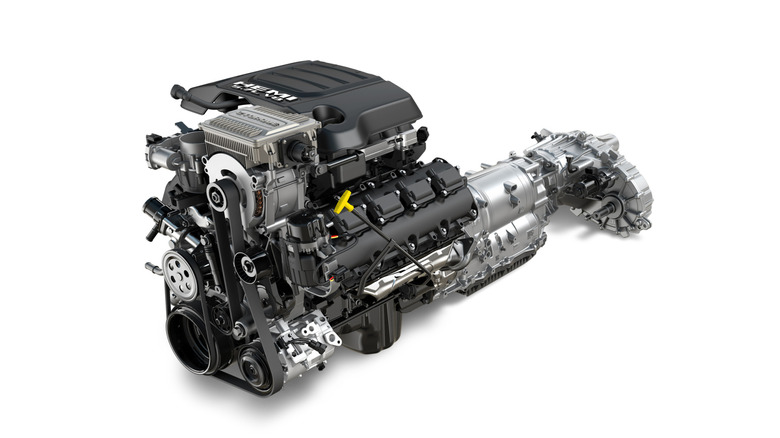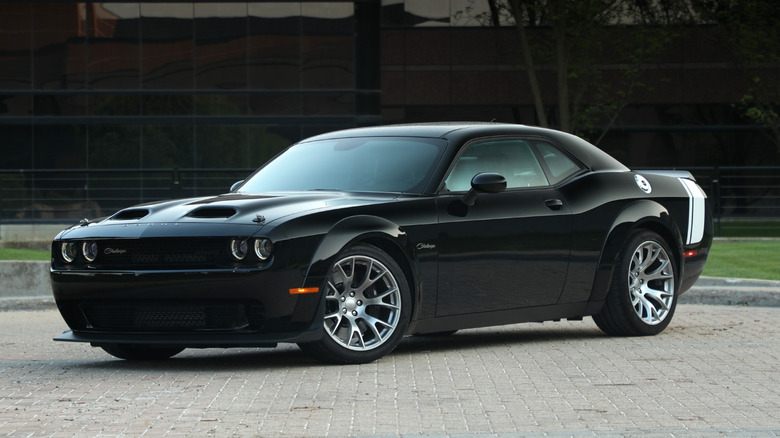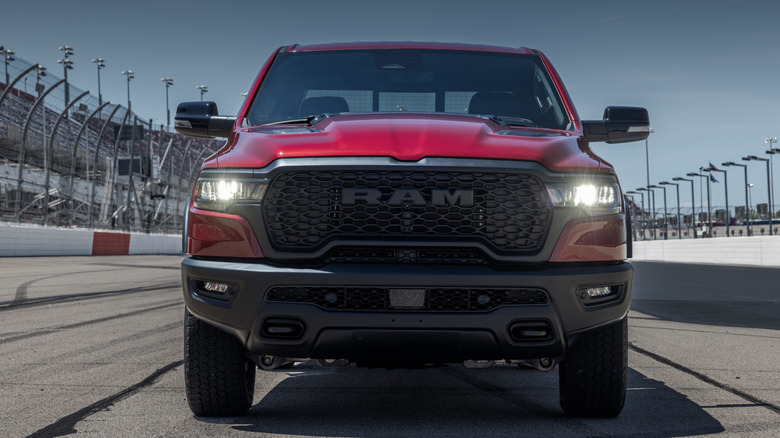Do Hemi Engines Require Premium Gas? Here's Which Rating Chrysler Recommends
The Hemi engine has been a staple of Chrysler's lineup since the 1950s, with the latest iteration featuring multiple flavors: the 5.7L, 6.4L, and supercharged 6.2L displacements. These engines are found in various Chrysler models, ranging from muscle cars to medium-duty pickup trucks, each with its own unique operating expectations. As such, these engines are both respectably powerful and versatile, with the base 5.7L producing some 395 horsepower and 410 lb/ft torque. Being that it's not a particularly specialized or unique powertrain that's found across such a broad range, these predictably don't have much in the way of fuel restrictions — but it's certainly not a one-size-fits-all. And each engine configuration also confusingly requires different minimum octane levels.
In order, Stellantis recommends 89 octane for the 5.7L, an easier 87 octane for the 6.4, and 91 octane for 5.7L engines married to manual transmissions, high-performance 6.4L engines, and the supercharged 6.2L. Additionally, the 6.2L found on the Dodge Challenger Demon 170, one of the few production cars boasting over 1,000 horsepower, is optimized for E85 ethanol fuel rather than straight gasoline. This car has a sensor that detects ethanol levels and, if the fuel contains 65% or more ethanol, all 1,025 horsepower is available. Otherwise, all Hemi engines use regular unleaded without ethanol, though other additives are also available. Let's discuss what those are on a per-engine basis, as well as why each engine uses its specific octane rating more in-depth.
Which engines require which octane levels and why they're different
Contrary to popular belief, higher octane doesn't actually increase power. Rather, octane rating is a measure of a fuel's resistance to pre-ignition, or "knocking." It's crucial for an engine's fuel to burn predictably for that engine to remain reliable at different RPMs, so higher-performance engines typically require better fuel to deal with the rigors of high compression ratios, forced induction, and so on. This includes the SRT 6.2L Hemi, a supercharged variant capable of delivering over 700 horsepower at base trim; this engine uniquely requires either 91+ octane, or E85 ethanol in the hotter Demon 170 configuration.
The more pedestrian variants, namely the 5.7 and 6.4, don't boast such requirements because they're comparatively understressed, with about 50 percent less power than the Hellcat counterpart. The key word to associate with octane is "stress." It's not going to destroy the engine if you run a lower octane rating, but engines are tuned to react to fuel in specific ways. If the fuel deviates from this predicted behavior, it may cause undue stress on certain working components, and that's exacerbated by higher performance.
For example, the 6.4L in the Ram 2500 uses a 10.0:1 compression ratio, whereas the 6.4L in the 392 Scat Pack has a 10.9:1 compression ratio. Consequently, the latter requires a recommended 91 octane to offset the performance advantage. Using less-optimal octane ratings leads to lower fuel efficiency, increased risk of wear and knocking, and other detriments.
What about ethanol, additives, and reformulated fuels?
E85 ethanol is utilized exclusively in the ultra-high performance sector of Hemi engines, with regular unleaded gasoline used for virtually everything else. However, there are numerous DIY kits that allow for flex-fuel capability in Hemi powerplants, among other popular brands. These function by intercepting the normal signal sent to the ECU, which detects the vehicle's fuel content and optimizes it for ethanol fuel instead. Additionally, other modifications may be required to the fuel lines and injection system, depending on what kit you use. Without such a kit, a non-flex-fuel-capable vehicle using E85 ethanol faces numerous problems, ranging from poorer fuel efficiency to corroded fuel lines from the degrading effects of ethanol on rubber.
As for octane boosters and other additives, Stellantis doesn't carry bespoke additive options tailor-made to Hemi engines, although numerous third-party blends are available. Different additives can help offset certain issues associated with lower octane ratings, such as worsened fuel efficiency and knocking issues. Similarly, Hemi engines are fuel-injected, and so they benefit from injector cleaner treatments. Aside from these, the manufacturer recommends using high-quality gasoline with detergent, corrosion prevention, and stability additives to maintain consistent long-term reliability of the fuel system. More specifically, Stellantis recommends designated Top Tier detergent gasoline by name, and reformulated gasoline with oxygenates that improve air quality in a broader sense for Hemi engines.
To summarize, Stellantis recommends high-quality gasoline with anti-wear properties, and the octane ratings themselves vary depending on your car's performance level. Generally speaking, the more horsepower under the hood, the higher the recommended octane rating will be.


